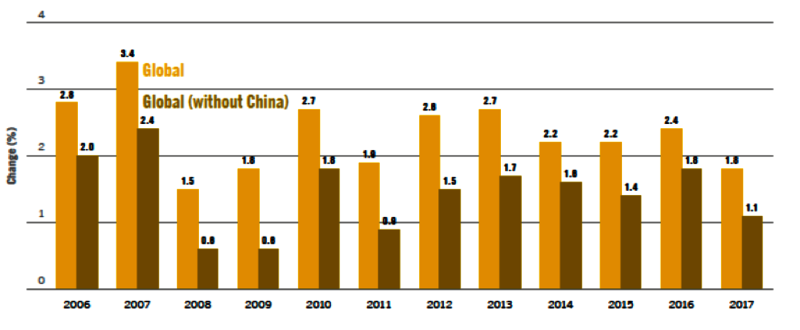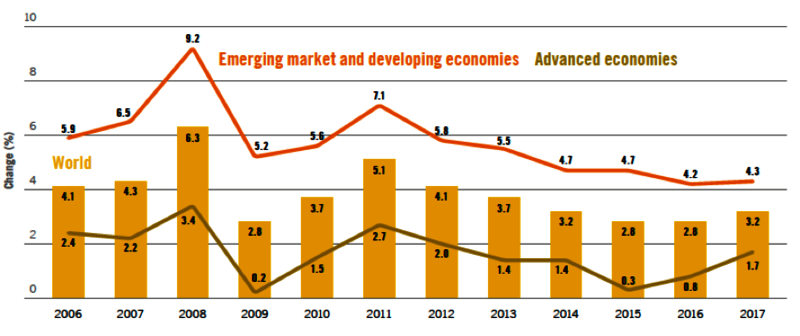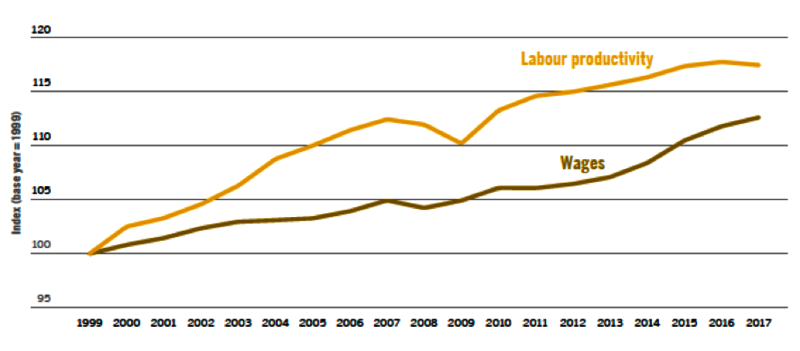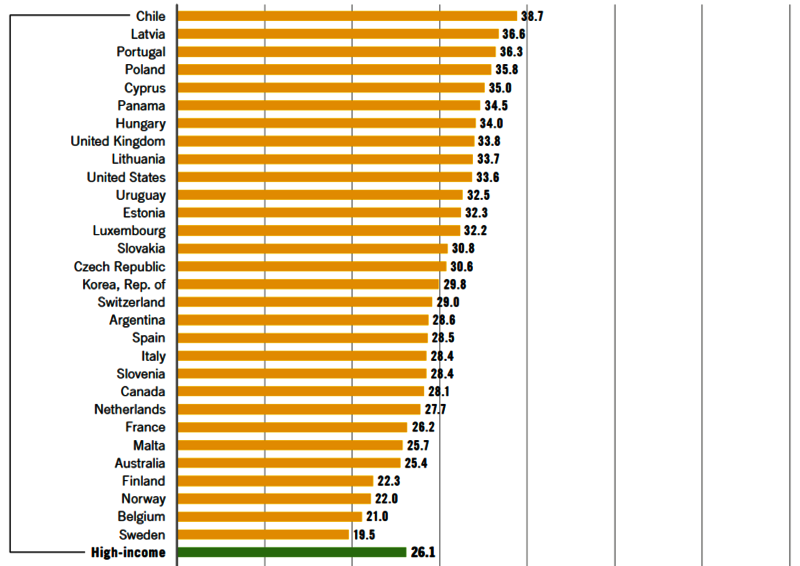The employment situation of wage earners in the world is deteriorating amid an unstable environment
- Differences in working conditions between the continents of the world are being reduced. While European wages are frozen, Asians remain on a clear upward trend. In Western countries, labor productivity has grown more than wages in the last two decades.

LABOUR ECONOMY: Bilbao Hiria irratia and Hordago collaborate
According to the latest data, 62% of the working-age population is employed, i.e. 3.3 billion people. But employees account for only 54% of employees, that is, 1.8 billion people. What has happened to real wages in recent years? Real wages take account of inflation, i.e. the cost of living. Wage growth in 2017 was lower than in the previous year and is also the lowest since 2009. This restrictive trend is taking place at the G20, China and globally. On the contrary, in developing countries, growth is much more notable.
Increase in average annual real wages 2006-2017

For its part, economic growth has slowed down. This paralysis is more evident in developed countries, where economic growth has been based on exports and investment costs, while in developing countries the locomotives of this growth have been private consumption and investment.
Average annual economic growth 2006-2017 (GDP at constant prices)

The increase in inflation has been directly affected by real wages, as nominal wage growth has been very moderate. As a result, real wages have been reduced around the world. Moreover, in developed countries the spectre of deflation has been distanced by rising food and energy prices.
Inflation 2006-2017 (average consumer prices)

The most striking thing in high-income countries is not the reduction in unemployment at the stage of economic growth, but the reduction in real wages. The average unemployment rate in the European Union was around 6.5% in April 2018, compared with 3.8% in the United States, the lowest rate since the 1960s. Experts said that there was an inverse relationship between unemployment and wages, but neither in 2016 nor in 2017 was that relationship reached. In developing countries, the International Labour Organization believes that informal work is widespread in order to survive, as unemployment is not an option. 60 per cent of the world ' s workers survive thanks to the informal economy. In the countries of the South Sahara this rate stands at 90%.
By region, different situations
Among the world’s workers, those who grew the most in real wages were those in Asia and the Pacific, especially those in China, India, Thailand and Vietnam. However, the trend of this growth is also decreasing. It should be noted that the real wages of Western workers, Hegoalde and Iparralde do not increase in 2017. In Latin America and the Caribbean the situation improved a little in 2017, leaving behind the bad situation of previous years, and the trend of African countries, which have improved slightly less than Egypt and Nigeria, is noteworthy. In Egypt there was a sharp devaluation of the currency that led to inflation, while in Nigeria development was due to oil prices, which have been seriously affected.
Increase in average annual real wages by region 2006-2017
.jpg)
Wages and productivity in high-income countries
According to some experts, companies, in an uncertain economic context, have avoided wage increases and, in addition, the position of workers in collective bargaining has been weakened. New technologies, the growth of global competitiveness, the widespread use of part-time jobs and the reduction of the number of union workers are the pillars of this trend.
Trends in labour productivity and real wages in developed countries, 1999-2017

Widening the wage gap
The wage gap is very different in each country. Using the Gini coefficient, we can analyze the distribution of wages of the population: those with lower values (closer to zero) will have lower wage differences, while those with higher values (around 100) will have higher wage differences.
In countries with higher incomes, the Gini index is lower (i.e., less inequality); the more countries with lower incomes, the difference will be higher. We can identify four groups: the Gini index of high-income countries is 26.1, 40.5 in upper-middle-income countries, 37.1 in lower-middle-income countries and 47.3 in low-income countries.
Gini Index of Wage Differences



As a conclusion
The wage trend in our small territory is not a local curiosity, but is being borne, to a greater or lesser extent, by workers around the world. Overall, economic growth has had little impact on wages, as countries that break the average are mostly in Asia. It is noteworthy, however, that real wage growth is also decreasing in these countries.
In developed countries, productivity has not directly influenced wages, but has gone into the pockets of capitalists. And wage differences, of course, are more evident in the poorest countries: the more well-being, the less wage differences.
Capital is advancing its class struggle; this is demonstrated by the trend in real wages. In order to oppose this, workers must increase their power in order to be able to act vigorously in collective bargaining. And of course, it has to put an end to this system that binds us; put an end to capitalism. The trend described within this economic system is the basis for its functioning.
ECONOMY OF WORK IN BILBO HIRIA IRRATIA. LINK HERE
ARGIA: Bangladesh textile workers strike
Since the collapse of the Rana Plaza building in 2013 and the death of more than a thousand workers, the employment situation of women dependent on multinationals has not improved. Argia has analysed the strike of thousands of workers in the textile sector in Bangladesh, which will affect 24,000 workers. About half a hundred factories closed their doors and the violence used by the police in the riots killed a man's life. Amaia Lekunberri, journalist of Argia in BilboHiria irratia, explained that employers have responded with the rise in wages and the dismissal of strikers.
UNION AGENDA
In collaboration with Ecuador Etxea and trade unions
1 February, Friday
- Today, 1 February, a strike has been called in Simply Bizkaia. The strike has been disconvened by the pre-agreement. Mobilisations have been suspended while the other points are being negotiated (ESK, LAB).
- The mediators of Tabakalera are still on strike.
- The cleaning workers of the courts and police stations of Gipuzkoa continue to strike (ELA, LAB, ESK, UGT).
- SATSE will hold a collection of signatures in favor of the ratios of Nursing: on February 2 in Vitoria-Gasteiz, at the exit of Jesús Guridi Street in El Corte Inglés (10:00-14:00); on 6 at the entrance of the Hospital de Cruces; on 7 in Vitoria-Gasteiz, in the universities, in front of the Las Nieves de la Calle.
- In Vitoria-Gasteiz, a worker has been dismissed at the Hotel Palacio de Elorriaga for a case of pregnancy. The mobilization will take place at 12:00 noon (LAB).
- Concentration of LAB metal delegates at the headquarters of the FVEM employers, at 12:00 hours.
- On the occasion of the preparatory work for the March 8 Feminist Strike, several meetings are being held: Today in Gernika at 17:00 in Astra; in Bermeo at 19:00 in Kabidx; in Altza at 19:00 in the house of culture Herrera; in Oñati on 5 February in the meeting point of Eltzia at 18:00; in Donibane at 18:30 in San Juan Xarre.
2 February, Saturday
- Lantegi Batuak workers will be demonstrating in Bilbao in defence of the agreement (ELA, LAB, CCOO, UGT), according to company sources. #Lantegi Batuak Borroka.
Call for strike at the H&M stores in Bizkaia (LAB, ELA).
- “No one is illegal” in Donostia, from Boulevard, at 12:00.
4 February, Monday
- Concentration in favour of decent pensions in front of the City Council of Bilbao, at 12:00. In Vitoria-Gasteiz it will also be.
5 February, Tuesday
- Concentration at the Arrasate Hospital at 10:30 (LAB, ESK) to show support to people who reported the irregularities of the Osakidetza OPE.
Wednesday, 6 February
- The workers of La Naval have called for a mobilization in Madrid to denounce the death of the worker.
Thursday, 7 February
- As of February 7, ESK workers will start a strike on the agreement they maintain with the company ABB in the Gipuzkoan locality.
- The Navarro Medical Union has called for a strike in all the hospitals of Navarra on 7, 14, 21 and 28 February at the Hospital Complex Navarra.
8 February, Friday
The workers of the Osakidetza Emergency Service will concentrate at 9:00 (SATSE, ELA, LAB, ESK, CCOO, UGT, Medical Union) in Vitoria-Gasteiz to call for a negotiation before the Basque Parliament.
This chronicle has been published by Hordago and we have brought it to ARGIA thanks to the CC-by-sa license.










.jpg)












